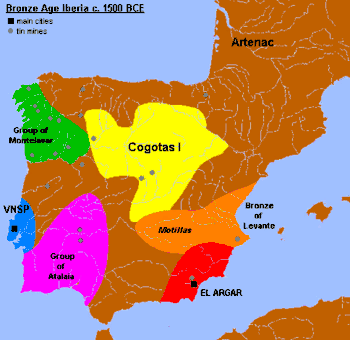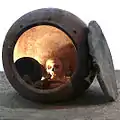El Argar
El Argar is an Early Bronze Age archaeological site located in Antas, Almería.[1] It developed sophisticated pottery and ceramic techniques, which they traded with other Mediterranean tribes.[2]

The civilization of El Argar extended to all the province of Almería, north onto the central Meseta, to most of the region of Murcia and westwards into the provinces of Granada and Jaen.[3]
Its cultural and possibly political influence was much wider, clearly influencing eastern and southwestern Iberia (Algarve), and possibly other regions as well.
Some authors have suggested that El Argar was a unified state.[3]
Material culture
El Argar is the center of the Early and Middle Bronze Age in Iberia. Metallurgy of bronze and pseudo-bronze (alloyed with arsenic instead of tin). Weapons are the main metallurgic product: knives, halberds, swords, spear and arrow points, and big axes with curved edge are all abundant, not just in the Argaric area but also elsewhere in Iberia. Silver is also exploited, while gold, which had been abundant in the Chalcolithic period, has become less common.
Periodization
The culture of El Argar has traditionally been divided in two phases, named A and B.
El Argar A
This phase started in the 18th century BC, with the earliest calibrated C-14 dates pointing to the first half or this century:
- 1785 BC (+/- 55 years) in the transitional Late Chalcolithic-Early Bronze of Cerro de la Virgen de Orce, a peripheral site.
- 1730 BC (+/- 70 years) in Fuente Álamo for El Argar A2, with six undated A1 layers under it.
- 1700 BC in Cuesta del Negro (another peripheral site) with clear Argarian materials in its lower layer.
El Argar B
This phase begins in the 16th century BC. The main C-14 date is that of 1550 BC (+/- 70 years) in Fuente Álamo for the upper layer of El Argar B2 (with four layers underneath the lowest B phase). Other stratigraphic dates are somewhat more recent but are not confirmed by C-14.
Post-Argarian phase
El Argar B ends in the 14th or 13th century BC, giving way to a less homogeneous post-Argarian culture. Again Fuente Álamo gives the best C-14 dating with 1330 BC (+/- 70 years).
Recent trends
Many more C-14 dates have been published since the beginning of the 21st century. In recent publications, at least 260 such dates are cited altogether. There's now a widespread consensus that the emergence of El Argar can be dated at 2200 cal BC, although its end is still somewhat disputed. Various opinions place the end of El Argar at 15th-14th centuries.[4]
Gallery
References
- Lull, Vicente; Micó, R.; Rihuete Herrada, Cristina; Risch, Roberto (2011). "El Argar and the Beginning of Class Society in the Western Mediterranean". Archäologie in Eurasien. 24: 381–414.
- Lull, Vincente; Micó, R.; Rihuete Herrada, Cristina; Risch, Roberto (2013). "Bronze Age Iberia". The Oxford Handbook of the European Bronze Age. Oxford University Press: 594–616. ISBN 9780199572861.
- Eiddon, Iorwerth; Edwards, Stephen (1973). The Cambridge Ancient History. p. 764.
- Gonzalo Aranda Jimenez, Sandra Montón Subías, Margarita Sánchez Romero, The Archaeology of Bronze Age Iberia: Argaric Societies. Volume 17 of Routledge Studies in Archaeology, 2014 ISBN 1317588916 p34
Bibliography
- Castro, Pedro V. (2001). "La sociedad argárica". In Ruiz-Gálvez Priego, Marisa (ed.). La Edad del Bronce ¿Primera Edad de Oro de España? Sociedad, economía e ideología. Barcelona: Crítica. ISBN 84-8432-299-8.
- Eiroa García, Jorge Juan (2010). Prehistoria del mundo (1st ed.). Barcelona: Sello Editorial SL. ISBN 978-84-937381-5-0.
- Gilman Guillén, Antonio (1999). "Veinte años de Prehistoria funcionalista en el sureste de España". Boletín del seminario de estudios de Arte y Arqueología (BSAA) (65): 73–98. Retrieved 8 April 2018.
- González Marcén, Paloma; Lull, Vicente; Risch, Robert (1992). Arqueología de Europa, 2250-1200 a. C. Una introducción a la "Edad del Bronce" (1 ª ed.). Madrid: Síntesis. ISBN 84-7738-128-3.
- Izquierdo Egea, Pascual (2016). "Midiendo las fluctuaciones de la economía argárica a través del registro funerario" (PDF). Arqueología Iberoamericana. 30: 77-90. ISSN 1989-4104.
- Lull, Vicente (1983). "La cultura del Argar. Un modelo para el estudio de las formaciones económico-sociales prehistóricas" (PDF). Madrid. Archived from the original (PDF) on 1 October 2018. Retrieved 8 April 2018. Cite journal requires
|journal=(help) - Siret, H.; Siret, L. (2006) [1890]. Las primeras edades del metal en el sudeste de España (Álbum) (pdf). Edición facsimilar. Murcia: Museo Arqueológico de Murcia. Retrieved 8 April 2018.
External links
- Official website
 Media related to El Argar at Wikimedia Commons
Media related to El Argar at Wikimedia Commons
.png.webp)
.png.webp)

.png.webp)
